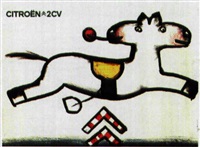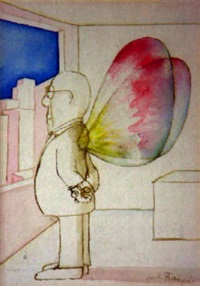Andre Francois

Andre Francois is a French graphic artist, cartoonist, and illustrator who was born on November 9, 1915 in Temesvar, Hungary(now part of Romania). He was the youngest child of Albert Farkas who was a Jewish businessman and Olga Ploen, a Viennese. In 1932, he attended the Academy of Fine Arts in Budapest and was inspired by the art done by AM Cassandre and the mass-produced graphic art around him. Cassandre would invite Francois to his school in Paris, thus, Francois went to Paris to study with Cassandre in 1934. In 1939, Francois became a French citizen and would marry to a British woman named Margaret Edmunds. His first work was designing posters for the French department store
Galeries Lafayette and was later commissioned to do graphic works for the 1937 World Exhibition in Paris. Along with doing posters, Francois would draw cartoons in newspapers and magazines. His witty and elegant illustrations would help Francois to international fame as his works would appear in magazines like Action, Architecture d’Aujourd’hui, Elle, Le Fou Parle, Haute Société, etc. With the coming of WW2, Francois and his wife moved to Marseilles and then Savoie but later returned to France in his family’s farmhouse after the war was over. In 1946, Francois began to publish his first children book
Issy-Les-Brioches. A year later, he would do work for
Diderot’s Jacques Le Fataliste and John Symonds’s William Waste. By the end of the decade, Francois would even do illustrations for American magazines like Vogue, Fortune, Life, Sports Illustrated, etc. He would also make ads and TV ads for companies like Kodak and Olivetti. Francois would become friends with
Ronald Searle and Germano Facetti who were art directors of Penguin books, and through them, Francois would illustrate countless book covers. In total, Francois created 57 covers for magazines and books. Francois would later exhibit one-man shows to exhibit his art in numerous museums around the world in cities such as Paris, Tokyo, Hanover, and Munich. Sadly, many of his original work and private collection were destroyed when his studio caught on fire in 2002. Despite this, Francois still continued to do his work. Francois would also design sets and costumes for theatres in England and France including the Royal Shakespeare Company. From the 1960s, Francois moved on from illustration to do fine art such as painting, engraving, and sculpting. In 1977, Francois received an honorary decorate award from the University of London. Francois died in 2005 due to a heart and kidney failure.
From the 1950s to the 80s, Francois’s work became popular in French satirical magazines, American magazines, and children books. Unlike the realistic illustration style happening in America, European illustrators embraced abstract and impressionist art styles. Francois is known for his crude but sensual black and white brush drawing and starkly colour paintings which creates a surreal and ironic juxtaposition. This style would make Francois’s work rather whimsical but occasionally, he would put eroticism in his work for comedic effect. His style varied as time went on but in his later life, Francois would experiment with vibrant colours and collage. Francois’s illustrations are interesting, to say the least. His style is simplistic and innocent but at times feel very abstract and crude. His childish art style approach gives his work more an expressionist feel to it and at times feels dark. However, I can see why his works would influence future illustrators as some of his work is very cartoony.




Sources
https://www.theguardian.com/news/2005/apr/21/guardianobituaries.france
http://artdaily.com/news/13355/French-Illustrator-Andr–Francois–89–Dies#.XGn_m1VKiUk
https://www.britannica.com/biography/Andre-Francois
https://fineartamerica.com/featured/new-yorker-june-24th-1974-andre-francois.html?product=art-print
http://www.findartinfo.com/english/art-pictures/3/95/0/Color%20Offset/page/71.html

Leave a Reply